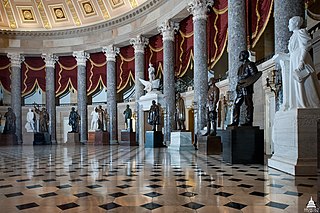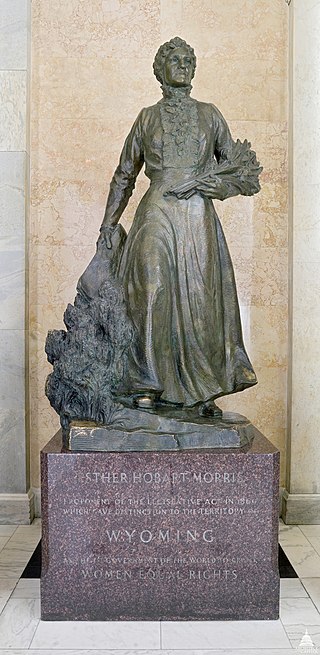
The United States Capitol, often called the Capitol or the Capitol Building, is the seat of the United States Congress, the legislative branch of the federal government. It is located on Capitol Hill at the eastern end of the National Mall in Washington, D.C. Although no longer at the geographic center of the national capital, the U.S. Capitol forms the origin point for the street-numbering system of the district as well as its four quadrants. Like the principal buildings of the executive and judicial branches, the Capitol is built in a neoclassical style and has a white exterior.

The National Statuary Hall is a chamber in the United States Capitol devoted to sculptures of prominent Americans. The hall, also known as the Old Hall of the House, is a large, two-story, semicircular room with a second story gallery along the curved perimeter. It is located immediately south of the Rotunda. The meeting place of the U.S. House of Representatives for nearly 50 years (1807–1857), after a few years of disuse it was repurposed as a statuary hall in 1864; this is when the National Statuary Hall Collection was established. By 1933, the collection had outgrown this single room, and a number of statues are placed elsewhere within the Capitol.

The National Statuary Hall Collection in the United States Capitol is composed of statues donated by individual states to honor persons notable in their history. Limited to two statues per state, the collection was originally set up in the old Hall of the House of Representatives, which was then renamed National Statuary Hall. The expanding collection has since been spread throughout the Capitol and its visitor center.

Maria Louise Sanford was an American educator. She was a professor of history at Swarthmore College from 1871 to 1880 and a professor of rhetoric and elocution at the University of Minnesota from 1880 to 1909.

The United States Capitol Complex is a group of twenty buildings, grounds, and facilities in Washington, D.C., that are used by the United States Congress, and federal courts. The buildings and grounds within the complex are managed and supervised by the Architect of the Capitol.

The United States Capitol Visitor Center (CVC) is a large underground addition to the United States Capitol complex which serves as a gathering point for up to 4,000 tourists and an expansion space for the U.S. Congress. Opened in 2008, it is located on 1st Street East below the landscaped tree-shaded grounds of the East Front of the Capitol and included the development of the surface plaza. Additional, transparent skylights also punctuate the surface plaza to allow light into the center. The complex contains 580,000 square feet (54,000 m2) of space below ground on three levels. The overall project's budget was $621 million dollars.

The United States Capitol building features a central rotunda below the Capitol dome. Built between 1818 and 1824, the rotunda has been described as the Capitol's "symbolic and physical heart".

The Lincoln catafalque is a catafalque constructed in 1865 to support the casket of Abraham Lincoln while the president's body lay in state in the Capitol rotunda in Washington, D.C. The catafalque has since been used for many who have lain in state in the Capitol rotunda.
Alvin Wayne Casey was an American guitarist. He was mainly known for his work as a session musician, but also released his own records and scored three Billboard Hot 100 hits in the United States. His contribution to the rockabilly genre has been recognized by the Rockabilly Hall of Fame.

Columbus Doors (1855–1861), also known as the Rogers Doors, are a pair of massive bronze doors modeled by sculptor Randolph Rogers for the East Front of the United States Capitol in Washington, DC. They open into the Rotunda, and depict events from the life of Christopher Columbus.

Evelyn Raymond was an American sculptor. Raymond lived in Duluth, Minnesota. In 1928 she received a scholarship to the Minneapolis School of Art.

The National Statuary Hall Collection holds statues donated by each of the United States, portraying notable persons in the histories of the respective states. Displayed in the National Statuary Hall and other parts of the United States Capitol in Washington, D.C., the collection includes two statues from each state, except for Virginia which currently has one, making a total of 99.

Andrew Jackson is a 1928 bronze sculpture of Andrew Jackson by Belle Kinney Scholz and Leopold Scholz, installed in the United States Capitol, in Washington D.C., as part of the National Statuary Hall Collection. It is one of two statues donated by the state of Tennessee. The statue was accepted into the collection by Senator Kenneth McKellar on April 16, 1928.

Esther Hobart Morris is a bronze sculpture depicting the first woman justice of the peace in the United States by Avard Fairbanks.

A bronze sculpture of an American journalist and politician Ernest Gruening by George Anthonisen is installed in the United States Capitol Visitor Center, in Washington, D.C., as part of the National Statuary Hall Collection. The statue was gifted by the U.S. state of Alaska in 1977.

Julius Sterling Morton, also known as J. Sterling Morton, is a 1937 bronze sculpture of Julius Sterling Morton by Rudulph Evans, installed in the United States Capitol Visitor Center, in Washington, D.C., as part of the National Statuary Hall Collection. It is one of two statues donated by the state of Nebraska. The sculpture was accepted into the collection by Congressman Karl Stefan of Nebraska on April 27, 1937.
Francis Harrison Pierpont is a 1910 marble sculpture of Francis Harrison Pierpont by Franklin Simmons installed in the United States Capitol, in Washington, D.C., as part of the National Statuary Hall Collection. It is one of two statues donated by the state of West Virginia. The sculpture was unveiled by the Hon. Thomas Condit Miller, on April 27, 1937.

Roger Sherman is an 1872 marble sculpture of Roger Sherman by Chauncey Ives, installed in the United States Capitol, in Washington, D.C., as part of the National Statuary Hall Collection. It is one of two statues donated by the state of Connecticut. The sculpture was unveiled by Senator Orris Sanford Ferry of Connecticut on March 8, 1872.

John Campbell Greenway is a 1930 bronze statue of John Campbell Greenway by Gutzon Borglum, one version of which was installed in the United States Capitol, in Washington D.C., as part of the National Statuary Hall Collection. It was one of two statues donated by the state of Arizona. The sculpture was unveiled by Senator Henry Ashurst of Arizona on May 24, 1930.

Pat McCarran, or Patrick A. McCarran, is a bronze sculpture depicting the United States Senator from Nevada of the same name by Yolande Jacobson, installed in the United States Capitol's Hall of Columns, in Washington, D.C., as part of the National Statuary Hall Collection. The statue was donated by the U.S. state of Nevada in 1960.


















